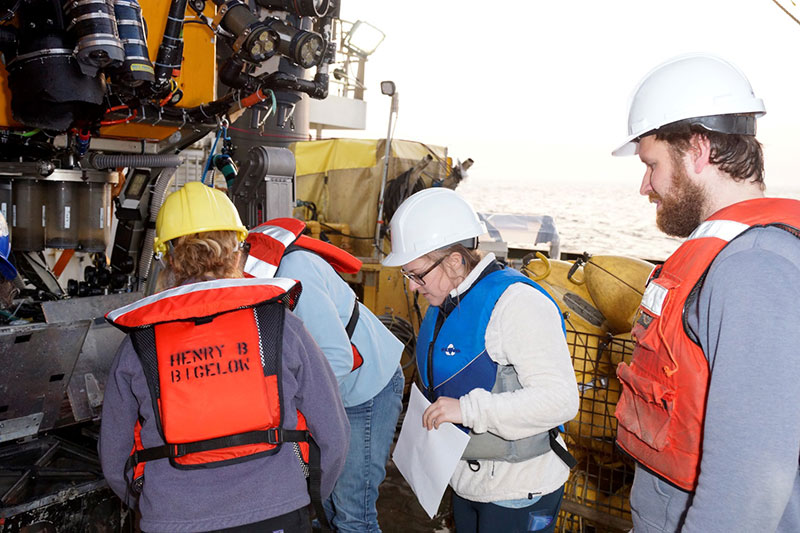
by Arieanna Balbar, Dalhousie University
June 17, 2017

Arieanna Balbar assists with retrieving biological samples collected by ROPOS. Image courtesy of Peter Lawton. Download larger version (jpg, 720 KB).
Preparing for my voyage debut, I was unsure what to expect. I will be gaining my ‘ship time requirement’ as a graduate student at Dalhousie University while on the Henry B. Bigelow. My main duty on the ship is to aid in the processing of collected specimens and organize the dive logs and video. Now that these action-packed two weeks of deep-sea exploration are well underway, here is a behind the scenes peek of the data tasks on a ROPOS cruise.
Now that cameras can produce high-definition video, we can (and will) collect thousands of gigabytes of video footage and high-quality still images covering transects of the seafloor and canyons that no human has ever seen before. The video collection is the major part of the overall data generated during this cruise, and it needs to be managed and archived for future processing. For this mission, this requires making four copies of each ROPOS dive: one each for the two chief scientists and two for other scientists who need the complete data set for their specific analyses. Each investigator brought more than 10 terabytes of hard drive space to store their precious data. It’s part of my daily tasks to check the footage to ensure no vital information is missing and manage the copy process for each investigator.

The remotely operated vehicle ROPOS control room on board NOAA Ship Henry B. Bigelow. Image courtesy of Peter Lawton. Download larger version (jpg, 957 KB).
In addition to multiple copies of the video footage from each dive, there is an integrated real-time logging system (IRLS) created by the ROPOS team. When ROPOS is in the water, we have someone recording what is being seen along the seafloor at all times. Using the IRLS, our observations are linked to the location, depth, and environmental conditions as well as frame grabs from the video at any particular location. High-quality still images can also be taken and are synchronized with the IRLS. This log gives participants and other future users an almost complete picture or record of the dive, and also creates an easy searchable database for anything that was logged or noted during the dive.
As I have learned so far, organization and problem solving are the name of the game. In order to transfer terabytes of data on a daily basis, we need to use USB-3 ports. During our first large file transfer, we ran into an issue with crashing computers due to the large volume of information being copied. Lucky for us, the ROPOS crew was more than prepared with extra computer power, and we were able to utilize it for our copying protocols. Since our initial hiccup, the copying, along with the cruise itself, have been smooth sailing.